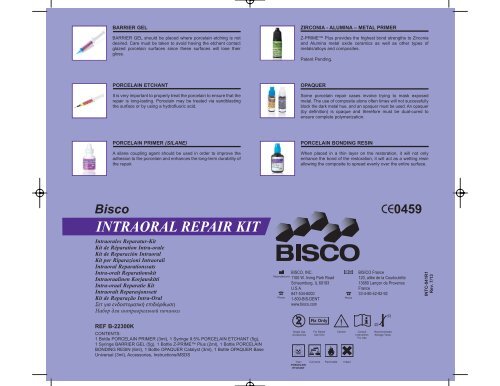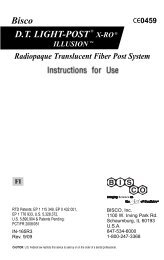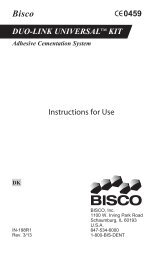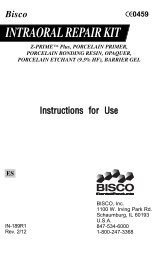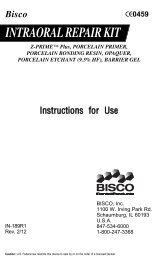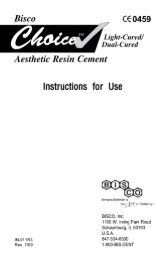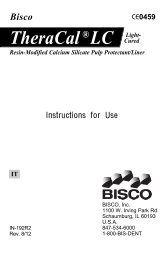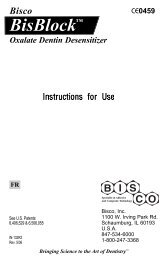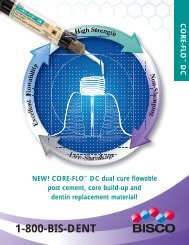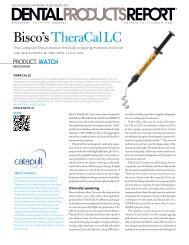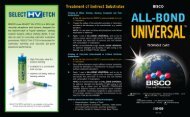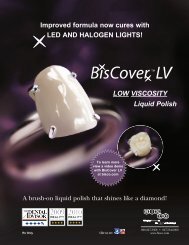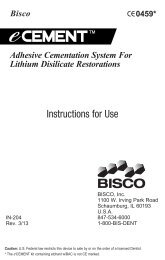intraoral repair kit technique card - Bisco, Inc.
intraoral repair kit technique card - Bisco, Inc.
intraoral repair kit technique card - Bisco, Inc.
Create successful ePaper yourself
Turn your PDF publications into a flip-book with our unique Google optimized e-Paper software.
BARRIER GELBARRIER GEL should be placed where porcelain etching is notdesired. Care must be taken to avoid having the etchant contactglazed porcelain surfaces since these surfaces will lose theirgloss.ZIRCONIA - ALUMINA – METAL PRIMERZ-PRIME Plus provides the highest bond strengths to Zirconiaand Alumina metal oxide ceramics as well as other types ofmetals/alloys and composites.Patent Pending.PORCELAIN ETCHANTIt is very important to properly treat the porcelain to ensure that the<strong>repair</strong> is long-lasting. Porcelain may be treated via sandblastingthe surface or by using a hydrofluoric acid.OPAQUERSome porcelain <strong>repair</strong> cases involve trying to mask exposedmetal. The use of composite alone often times will not successfullyblock the dark metal hue, and an opaquer must be used. An opaquer(by definition) is opaque and therefore must be dual-cured toensure complete polymerization.PORCELAIN PRIMER (SILANE)A silane coupling agent should be used in order to improve theadhesion to the porcelain and enhances the long-term durability ofthe <strong>repair</strong>.PORCELAIN BONDING RESINWhen placed in a thin layer on the restoration, it will not onlyenhance the bond of the restoration, it will act as a wetting resinallowing the composite to spread evenly over the entire surface.<strong>Bisco</strong>INTRAORAL REPAIR KITIntraorales Reparatur-KitKit de Réparation Intra-oraleKit de Reparación IntraoralKit per Riparazioni IntraoraliIntraoral ReparationssatsIntra-oralt Reparations<strong>kit</strong>Intraoraalinen Korjaus<strong>kit</strong>tiIntra-oraal Reparatie KitIntraoralt ReparasjonssettKit de Reparação Intra-OralΣετ για ενδοστοματική επιδιόρθωσηНабор для интраоральной починкиREF B-22300KCONTENTS:1 Bottle PORCELAIN PRIMER (3ml), 1 Syringe 9.5% PORCELAIN ETCHANT (5g),1 Syringe BARRIER GEL (5g), 1 Bottle Z-PRIME Plus (2ml), 1 Bottle PORCELAINBONDING RESIN (6ml), 1 Bottle OPAQUER Catalyst (3ml), 1 Bottle OPAQUER BaseUniversal (3ml), Accessories, Instructions/MSDSMaunufacturerBISCO, INC.1100 W. Irving Park RoadSchaumburg, IL 60193U.S.A.847-534-60001-800-BIS-DENTwww.bisco.com% %Phone2Single UseAccessoriesFor DentalUse OnlyCautionPhoneBISICO France120, allée de la Coudoulette13680 Lançon de ProvenceFrance33-4-90-42-92-92ConsultInstructionsFor UseCE0459RecommendedStorage Temp.INTC-041R1Rev. 7/13ToxicPORCELAINETCHANTCorrosive Flammable Irritant
WARNING: Do not use this product until you have thoroughly read and understood these instructions.Repair of Porcelain-Fused-to-Metal or Zirconia/Alumina RestorationsStep1Always use a rubber dam. The use ofa rubber dam during porcelain <strong>repair</strong>provides several benefits, includingisolation from saliva during bondingand soft-tissue protection when usinghydrofluoric acid <strong>intraoral</strong>ly.Step4Step7Step2Apply 1 coat of PORCELAIN PRIMER to theetched porcelain surface and allow to dwellfor 30 seconds. Dry with air syringe.Allow to self cure, or light cure for 5 seconds.An oxygen inhibited layer will be present onthe surface once the curing process hascompleted. This is normal for this material.Step5Step8Remove the glaze & bevel (45 degree) theporcelain around the area to be <strong>repair</strong>ed.Place BARRIER GEL on gingival tissue thatmay be exposed or porcelain to protect areaswhere etching is not desired.Step3Apply 1-2 coats of Z-PRIME Plus to theexposed metal/zirconia/alumina & dry with anair syringe for 3-5 seconds.Apply a thin layer of PORCELAIN BONDINGRESIN to the <strong>repair</strong> site. Spread compositeevenly over the surface and light cure.Step6Step9Remove cap from PORCELAIN ETCHANT,securely attach dispensing tip and verifyetchant flow prior to applying <strong>intraoral</strong>ly.Apply PORCELAIN ETCHANT (9.5% HF) tothe dry porcelain surface for 90 seconds.Continue to observe the etch site throughoutthe entire procedure. Suction the PORCELAINETCHANT, then rinse with a copious amountof water and air dry. The etched surfaceshould appear dull and frosty (if porcelainhas a white/chalky appearance, agitate amoist microbrush on the porcelain to removesalt and debris created by etching, rinse and dry).NOTE: Porcelain may be sandblasted orabraded with a coarse diamond bur as analternative to Hydroflouric Acid Etching.SEE INSTRUCTIONS FOR ADDITIONALWARNINGS RELATED TO PORCELAINETCHANTIf metal masking is required, shake OPAQUERBase and Catalyst bottles well beforedispensing. Dispense one drop each ofCatalyst and Base onto a mixing pad, andmix with a brush tip. Apply a thin coat ofOPAQUER only to the metal surface.ConsultInstructionsFor UseComplete the <strong>repair</strong> and finish/polish.See instructions for the following <strong>repair</strong>s:Repair of Porcelain & Lithium Disilicate RestorationsRepair of Old or Indirect Composite Restorations


